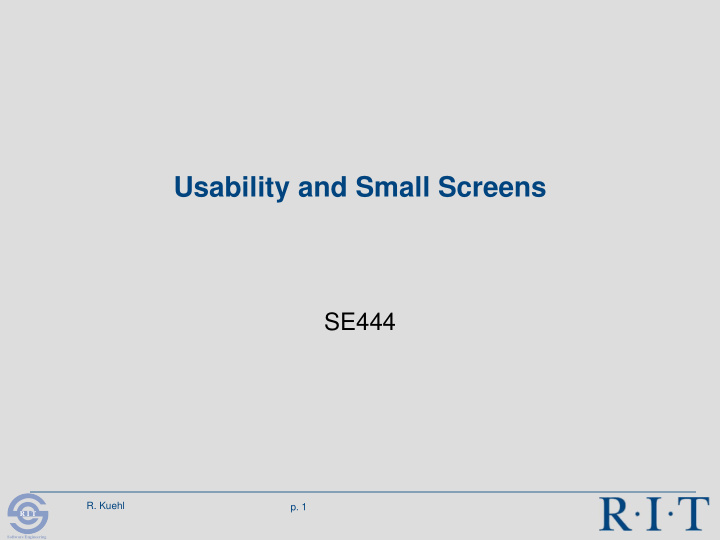



Usability and Small Screens SE444 R. Kuehl p. 1 R I T Software Engineering
iPhone Android Windows Phone 8 R. Kuehl p. 2 R I T Software Engineering
“The phrase ‘mobile usability’ is pretty much an oxymoron. It's neither easy nor pleasant to use the Web on mobile devices.” “designing for mobile is hard” “It’s not enough that a site will display, can the user get things done?” Jacob Nielsen, useit web site R. Kuehl p. 3 R I T Software Engineering
Small Screens We will focus on consumer mobile devices such as smartphones and tablets However, there is another large category of embedded devices to be considered as well Design guidelines apply equally to those devices with more constraints such as safety GPS Digital Camera Airplane Control R. Kuehl p. 4 R I T Software Engineering
Designing for Mobile Devices Form factors OS’s support full screen apps instead of windows Especially for handhelds Tablets borrow more interface patterns from the desktop About Face , Cooper, Reimann, Chapter 19 R. Kuehl p. 5 R I T Software Engineering
Mobile Usability Problems (Opportunities) Small screens (inherent) Awkward input (“fat finger syndrome”) Network performance and reliability , especially for downloads (but getting better) Mis-designed web sites – designed for the desktop just makes it worse (but getting better) R. Kuehl p. 6 R I T Software Engineering
Class Activity (Cont) For your RIT Library or SIS website design: Reference the mobile app design guidelines described in this lecture … Critique the responsive design of the existing website What are your design concepts for a mobile app? How would you change your web app design to be responsive to a small screen? Dropbox – “Class Activities>Website Design” R. Kuehl p. 7 R I T Software Engineering
Guidelines for Mobile Design Design goal - mitigate the constraints but exploit device features To preserve screen real estate … Use transparency; e.g., widgets Vertical or horizontal screen navigation Use images sparingly Minimize use of footers, breadcrumbs, progress indicators, menu bars Screen layout : Important information at top Most frequently used controls at bottom R. Kuehl p. 9 R I T Software Engineering
Guidelines for Mobile Design (cont) Limit navigational hierarchy , especially global to contextual transition, to avoid losing the user Apply Fitt’s Law : large objects for navigation (touch) versus hypertext Tradeoff? Apply screen layout design patterns; E.g …. Carousels Stacks Lists Grids Cards Tab bars Drawers R. Kuehl p. 10 R I T Software Engineering
Guidelines for Mobile Design (cont) Rapid serial presentation of text , important information first ( progressive disclosure ); however… Short text lines slows down reading speed - disrupt the normal pattern of eye movements Minimize extended scrolling or paging Optimize reading - lower screen resolution degrades information retrieval and interpretation 14pt fonts Organize text with headings R. Kuehl p. 11 R I T Software Engineering
Guidelines for Mobile Design (cont) Consider the physical feel – ergonomics, UX The use of the (one) hand – fingers, particularly for thumb convenience E.g., screen layout to accommodate thumb span Finger tip area guides standard tap target size (e.g., iPhone 44 pixels) R. Kuehl p. 12 R I T Software Engineering
Searching and Sorting Mobile apps are better at browsing , complex data entry is not easy or practical so … Minimize search effort Voice Auto-complete, auto suggest Recent/frequent searches Sort – provide a visible control to allow the user to specify and refine sorting criteria About Face , Cooper, Reimann, Chapter 19 R. Kuehl p. 13 R I T Software Engineering
References Lari Kärkkäinen and Jari Laarni, ” Designing for Small Display Screens”, NordiCHI, October 19- 23, 2002 uxmatters.com: Usability for Mobile Devices Josh Clark, Tapworthy – Designing Great iPhone Apps , O’Reilly Media, 2010 Alan Cooper, Robert Reimann , et al, “About Face”, Wiley, 2014 R. Kuehl p. 15 R I T Software Engineering
Recommend
More recommend